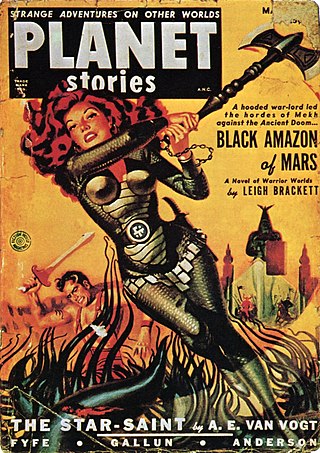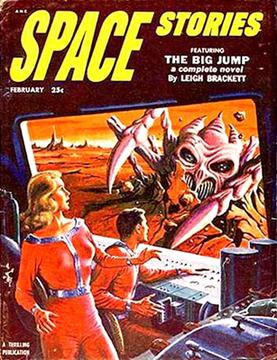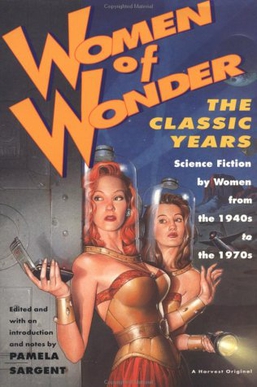Related Research Articles

The Magazine of Fantasy & Science Fiction is a U.S. fantasy and science fiction magazine, first published in 1949 by Mystery House, a subsidiary of Lawrence Spivak's Mercury Press. Editors Anthony Boucher and J. Francis McComas had approached Spivak in the mid-1940s about creating a fantasy companion to Spivak's existing mystery title, Ellery Queen's Mystery Magazine. The first issue was titled The Magazine of Fantasy, but the decision was quickly made to include science fiction as well as fantasy, and the title was changed correspondingly with the second issue. F&SF was quite different in presentation from the existing science fiction magazines of the day, most of which were in pulp format: it had no interior illustrations, no letter column, and text in a single-column format, which in the opinion of science fiction historian Mike Ashley "set F&SF apart, giving it the air and authority of a superior magazine".

Planet Stories was an American pulp science fiction magazine, published by Fiction House between 1939 and 1955. It featured interplanetary adventures, both in space and on some other planets, and was initially focused on a young readership. Malcolm Reiss was editor or editor-in-chief for all of its 71 issues. Planet Stories was launched at the same time as Planet Comics, the success of which probably helped to fund the early issues of Planet Stories. Planet Stories did not pay well enough to regularly attract the leading science fiction writers of the day, but occasionally obtained work from well-known authors, including Isaac Asimov and Clifford D. Simak. In 1952 Planet Stories published Philip K. Dick's first sale, and printed four more of his stories over the next three years.
The role of women in speculative fiction has changed a great deal since the early to mid-20th century. There are several aspects to women's roles, including their participation as authors of speculative fiction and their role in science fiction fandom. Regarding authorship, in 1948, 10–15% of science fiction writers were female. Women's role in speculative fiction has grown since then, and in 1999, women comprised 36% of the Science Fiction and Fantasy Writers of America's professional members. Frankenstein (1818) by Mary Shelley has been called the first science fiction novel, although women wrote utopian novels even before that, with Margaret Cavendish publishing the first in the seventeenth century. Early published fantasy was written by and for any gender. However, speculative fiction, with science fiction in particular, has traditionally been viewed as a male-oriented genre.

Space Stories was a pulp magazine which published five issues from October 1952 to June 1953. It was published by Standard Magazines, and edited by Samuel Mines. Mines' editorial policy for Space Stories was to publish straightforward science fiction adventure stories. Among the better-known contributors were Jack Vance, Gordon R. Dickson and Leigh Brackett, whose novel The Big Jump appeared in the February 1953 issue.
Alfredo Cardona Peña was a celebrated journalist, writer, biographer poet and essayist born in San José, Costa Rica. Cardona Peña lived and wrote for most of his career in Mexico, where he worked in comics for the publisher Novaro, and became "a singular figure in the history of Mexican science fiction."
The year 1911 was marked, in science fiction, by the following events.
The year 1917 was marked, in science fiction, by the following events.
The year 1919 was marked, in science fiction, by the following events.
The year 1921 was marked, in science fiction, by the following events.
The year 1923 was marked, in science fiction, by the following events.
The year 1925 was marked, in science fiction, by the following events.
The year 1926 was marked, in science fiction, by the following events.
The year 1927 was marked, in science fiction, by the following events.
The year 1928 was marked, in science fiction, by the following events.
The year 1929 was marked, in science fiction, by the following events.
The year 1934 was marked, in science fiction, by the following events.
The year 1935 was marked, in science fiction, by the following events.
The year 1936 was marked, in science fiction, by the following events.
The year 1937 was marked, in science fiction, by the following events.

Women of Wonder, The Classic Years: Science Fiction by Women from the 1940s to the 1970s is an anthology of short stories, novelettes, and novellas edited by Pamela Sargent. It was published in 1995, along a companion volume, Women of Wonder, The Contemporary Years: Science Fiction by Women from the 1970s to the Present.
References
- ↑ Gale, Steven H. (2016). Encyclopedia of American Humorists. Routledge. p. 473. ISBN 9781317362265.
- ↑ "Professor Sir Fred Hoyle" . The Independent. Archived from the original on 2022-05-01. Retrieved 20 July 2018.
- ↑ "James Tiptree, Jr. | American author". Encyclopedia Britannica. Retrieved 31 March 2019.
- ↑ Priest, Christopher (9 March 2007). "Obituary: David Masson". the Guardian. Retrieved 20 July 2018.
- ↑ Heritage Rare Books & Manuscripts Auction Final Session # 683. Heritage Capital Corporation. p. 102. ISBN 9781599672595.
- ↑ "Authors : Brackett, Leigh : SFE : Science Fiction Encyclopedia". www.sf-encyclopedia.com. Retrieved 31 March 2019.
- ↑ "Authors : Harness, Charles L : SFE : Science Fiction Encyclopedia". www.sf-encyclopedia.com. Retrieved 31 March 2019.
- ↑ McElheny, Josiah; Burgin, Christine (2014). Glass! Love!! Perpetual Motion!!!: A Paul Scheerbart Reader. University of Chicago Press. p. 145. ISBN 978-0-226-20300-3.